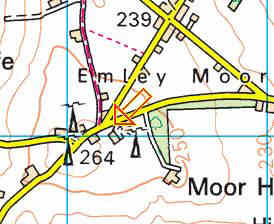 This Is Not A
BLOG!
This Is Not A
BLOG!
Date: 19/03/24
On Emley Moor 'Baht Tower
Fifty-five years ago this evening (that's 1969 to save you the effort of counting), a major event in British broadcasting history took place. But not one which has been commemorated with any hoopla or glossy presentations.
It was just after 1700hrs on a freezing cold late-winter evening when the 1265-foot television transmitter mast at Emley Moor between Huddersfield and Barnsley in Yorkshire came crashing to the ground.
The cylindrical steel mast had been built in 1966 to provide services on BBC2 and Granada (which was the commercial programme contractor for Yorkshire at that time) on the new UHF 625-line system.
Emley Moor is a predictably cold and windswept location, and both the mast and its supporting guy cables were prone to build-ups of ice which, when said ice thawed off enough, would send blocks of the stuff raining down on the rest of the site.

On the evening of 19 March 1969, during a particularly cold period (even by the standards of the eastern side of the Pennines), one of the guy cables couldn't handle the load any more and snapped. The resulting imbalance then led to the whole kit and caboodle coming down, scattering debris across the landscape and with one snapped cable cutting right through a nearby chapel, roof, walls, pews and all (and very nearly the church warden to boot).
(A committee of enquiry later came to the conclusion that the actual source of the failure was oscillation caused by the wind, but that just spoils the story)
When people - members of the public and broadcasting engineers alike - phoned the relevant authorities to find out what had happened to their television signals, the official explanation was greeted with variations on a theme of "Pull the other one!", but it was true; a supposedly state-of-the-art structure had failed in the most spectacular way, depriving two-and-a-half million Tykes of their Coronation Street.
All hands were called on to t'deck and, remarkably, the BBC2 service - albeit with a more limited reach - was restored within forty hours of the collapse by use of a mobile mast mounted on a BBC Outside Broadcast truck, and the Independent Television Authority (as it was called back then) managed to get the UHF service for Yorkshire Television (which had been awarded the local franchise the previous year, replacing Granada, which was confined to the area west of the Pennines) back on within a month. It was to be a further two years before a new replacement (concrete) mast standing 1084 feet tall was put into service.
This wasn't the first large transmitter mast which had toppled; the 950ft mast at Waltham-on-the-Wolds in east Leicestershire had collapsed in November 1966, but as it had not been completed and in service at that point, disruption to the public was limited to those living nearby who were worried about what might be coming through their roofs.
For a fuller picture (405 or 625 lines) of the Emley Moor collapse, along with a number of personal recollections, I recommend Mike Brown's excellent transmitter history site.

 This Is Not A
BLOG!
This Is Not A
BLOG!











